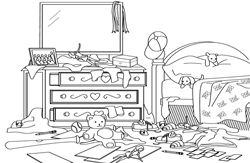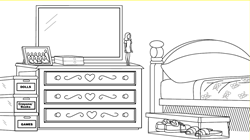|
If you or your child have allergies or asthma, you already know that many things can bring on, or "trigger," an asthma flare or episode. Some things that trigger asthma attacks are called allergens. Some people get symptoms from only one allergen - like dust mites. For other people, more than one kind of allergen can trigger an episode. Tobacco smoke is an asthma trigger. Avoid smoking in a home where a person with asthma lives.
Health professionals agree that controlling allergens in the home can significantly reduce symptoms for the millions of people who suffer from allergies or asthma. And cleaning is one of the first and easiest steps to controlling the most common indoor allergens that can trigger attacks. To help families control their home environment, ACI has developed asthma education materials tailored to the information needs of various audiences. |
|||||||||||||||
Cleaning Can Help
Cleaning can help control some allergens
It’s one of the easiest steps you can take to help reduce allergy or asthma flares (episodes).
Cleaning your home is one of the easiest steps you can take to help reduce allergy or asthma flares is to control triggers such as animal dander, cockroaches, dust mites, mold / mildew, pollen. If you don’t clean, the mildew, dust and other allergens will build up, making asthma symptoms worse. Here are more tips for cleaning to control allergies in your home:
- A supportive family can make all the difference in the life of an asthmatic. Work together to get rid of triggers at home – if everyone helps out, it can be easy and fun!
- For the asthmatic person(s) in the family, assign tasks like dishwashing and cleaning up daily clutter before it becomes dusty.
- When tackling other tasks — such as dusting, sweeping, or using cleaning products that could trigger allergies/asthma — make sure that the asthmatic person is out of the room.
- Read and follow label directions on cleaning products. The label directions give the proper amount of product to use, how to use the product and any special safety advice.
- If you use spray products, spray the cleaner on a cloth or sponge first instead of on the surface.
- Clean in a "well-ventilated" area – open a door and a window or turn on an exhaust fan. Leave the room when you are done cleaning and allow the room to air out.
- Try using cleaning products that have no scent or are perfume free.
- Try different products to find the ones that work best for you.
Bedroom
![]() 1. Use Dust Mite-Proof Covers
1. Use Dust Mite-Proof Covers
Use special dust mite-proof pillows and mattress covers. Wipe them off weekly with a clean, damp cloth.
2. Wash Bedding Regularly
Wash sheets weekly.
Wash blankets and bedspreads monthly.
3. Clean Window Coverings
Use smooth blinds or washable curtains.
Wipe blinds with a clean, damp cloth. Wash curtains monthly.
4. Dust and Vacuum Weekly
Dust furniture weekly, using a dusting product or special cloth that attracts dust (a dry cloth spreads dust around, it doesn't remove it).
Vacuum and wet mop floors weekly.
Tips:
- Keep closet doors closed.
- Set up a play area in another room where stuffed animals and other toys can be stored.
- Use vinyl, linoleum or wood flooring instead of carpeting.
Bedding
Dust mites in the bedroom are a trigger for people with allergies and asthma. Every home has dust mites. You can't see them; they feed on invisible skin flakes in pillows, bedding, upholstery and carpeting. You can control them by keeping bedding clean and controlling dust.
Warmth + Moisture + Skin = Dust Mites
To Control Dust Mites in the Bedroom
- Use special dust mite-proof covers to keep dust mites from going through pillows and mattresses. They're sometimes called "allergen-impermeable" covers. Wipe covers with a damp cloth every week. If you don't use covers, wash pillows at least 4 times a year, and replace them every year.
- Don't use carpet in the bedroom. Use linoleum, vinal or wood flooring and washable area rugs. Wash rugs once a week.
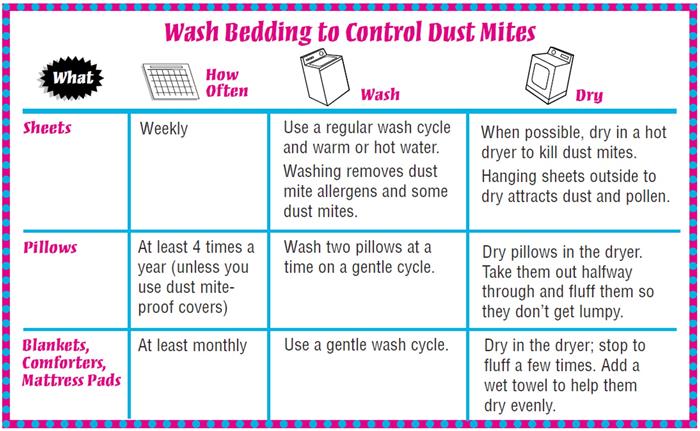
Bathroom
Mold and mildew are tiny plants that grow where it’s warm and damp — like in the shower. They release invisible "spores" into the air. The floating spores trigger allergy and asthma episodes. And wherever they land, the spores start growing new mold and mildew.
Warmth + Moisture = Mold and Mildew
Areas where mold and mildew are often found hiding:
- Where the floor meets the tub or shower
- Under the sink
- On window frames and sills
Mold/mildew also grow on "wet" appliances — like air conditioners, dehumidifiers (appliances that remove moisture from the air) and humidifiers (appliances that add moisture to the air). Follow manufacturer’s instructions to change filters and clean appliances regularly.
Kitchen
Cockroaches are attracted to food and moisture - including crumbs, cooking grease and plain water. It's important to remove or tightly cover all food and water, especially at night when cockroaches are more active.
Food + Water = Cockroaches
Cleaning the Kitchen
- Clean food and grease from stove daily. If possible, clean under and behind stove.
- Clean up food spills, crumbs and liquids on countertops and floors immediately.
- Empty trash daily. Clean and disinfect garbage cans and recycling bins weekly. Let the cans dry out before you put in a new garbage bag.
- Keep the cabinet under your sink dry and clean. Have leaks repaired.
- Clean the outside and inside of the refrigerator. If possible, vacuum underneath.
- Wash and dry dishes as soon as possible after eating.
- Wash floors at least weekly.
- Throw away or recycle grocery bags. Roaches like to live in them.
Cockroach Prevention Tactics
- Keep food in closed containers.
- Don't leave water sitting in open containers.
- Cover any food (including pet food) that will be left out overnight.
- Use baits or gel products to get rid of cockroaches. Follow instructions on the product.
- Seal any cracks around the walls or cabinets where cockroaches can get in.
Refrigerator
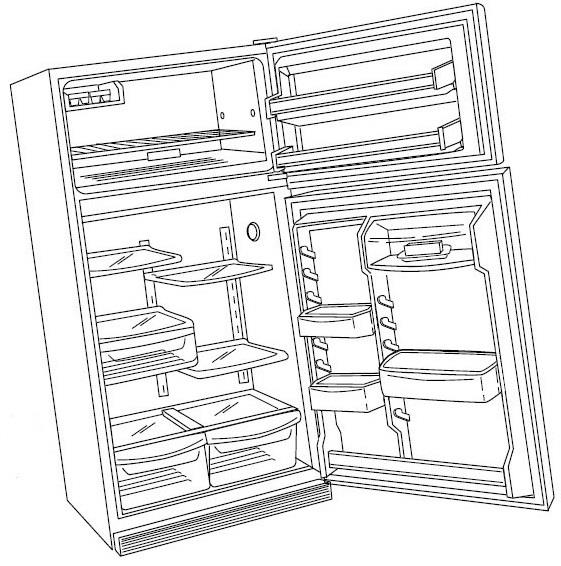 Cockroaches are often found around the refrigerator because of food spills and dampness. These spills and moisture also grow mold and mildew. Keeping your refrigerator clean is an important part of controlling allergens.
Cockroaches are often found around the refrigerator because of food spills and dampness. These spills and moisture also grow mold and mildew. Keeping your refrigerator clean is an important part of controlling allergens.
If you have the Owner's Manual, follow the cleaning instructions.
If you don't have the Manual, use these steps:
- Turn controls off.
- Unplug the refrigerator.
- Remove the grille and clean, using a hand dishwashing detergent or an all-purpose cleaner. You may need to ask your maintenance people to do this.
- Remove drip pan, then clean and disinfect it.
- Clean mildew on the rubber stripping around the refrigerator door using a solution of 3/4 cup bleach with 1 gallon water (or 3 tablespoons bleach and 1 quart water).
- Clean walls and shelves with all-purpose cleaner or a solution of baking soda and water.
- Wipe up any water in the inside drawers, and then clean them regularly.
- Clean up spills immediately, especially raw meat, poultry and fish juices. Use a disinfectant (antibacterial) cleaner.
Clutter Control
Want to save time and reduce allergens? Get rid of clutter!
|
|
1. Sort it Out
- Start with a bedroom and take everything out of the closet, dressers, shelves, under the bed.
- Put stuff in separate piles: clothes, shoes, toys, books, school supplies, sports equipment, etc.
- Work with your children to pick the toys and belongings that are most important, and separate those they don’t use any more.
- You can give old toys, books and clothes to a friend, community center or Head Start classroom. You can also sell them.
2. Give it a Home
- Keep similar items together so that children know where to find things. For example, keep school supplies near the desk or table where your children do homework; store videos by the VCR; toys in the play area, etc.
- Put children’s things in a place that’s easy for them to reach.
3. Cover It
- Put items inside drawers, closets, covered boxes or plastic containers so dust can’t collect on them. Put labels on containers to show where things belong. Have your children write or draw labels.
4. Use It
- Review the "clutter plan" with your children. Remind them that controlling clutter may help reduce asthma attacks. Have them try to put one thing back before getting out something else. Or, schedule 5 minutes of clean-up time every night.
Allergen-Control Plan
1. Work with your Doctor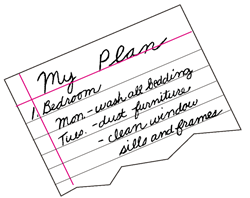
Work with your regular doctor or clinic to figure out which allergens affect your child or you the most.
If asthma flares happen a lot, you may need to see a doctor. He or she may suggest that you make changes in your household furnishings - like removing carpeting from a sleeping area
2. Concentrate on controlling those allergens
3. Start with the easiest, least expensive ways, like cleaning
Set up your cleaning plan one room at a time, beginning with where the allergy-sufferer sleeps. For example:
- wash bedding and curtains
- dust and vacuum
- clean window sills and frames
- wet mop floors
Tips:
- Ask your doctor or clinic for asthma education information.
- Join an asthma support group.
- Keep an asthma diary.
Publications and Links
Publications:
Links:
- Allergy & Asthma Network Mothers of Asthmatics - www.aanma.org
- Centers for Disease Control and Prevention: Asthma Facts and Data - www.cdc.gov/asthma/
- D.C. Asthma Coalition - www.dcasthma.org
- American College of Allergy, Asthma, and Immunology -
https://acaai.org/asthma





